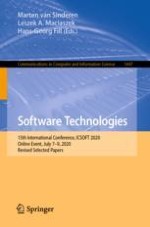2021 | Buch
Software Technologies
15th International Conference, ICSOFT 2020, Online Event, July 7–9, 2020, Revised Selected Papers
herausgegeben von: Dr. Marten van Sinderen, Leszek A. Maciaszek, Prof. Dr. Hans-Georg Fill
Verlag: Springer International Publishing
Buchreihe : Communications in Computer and Information Science
